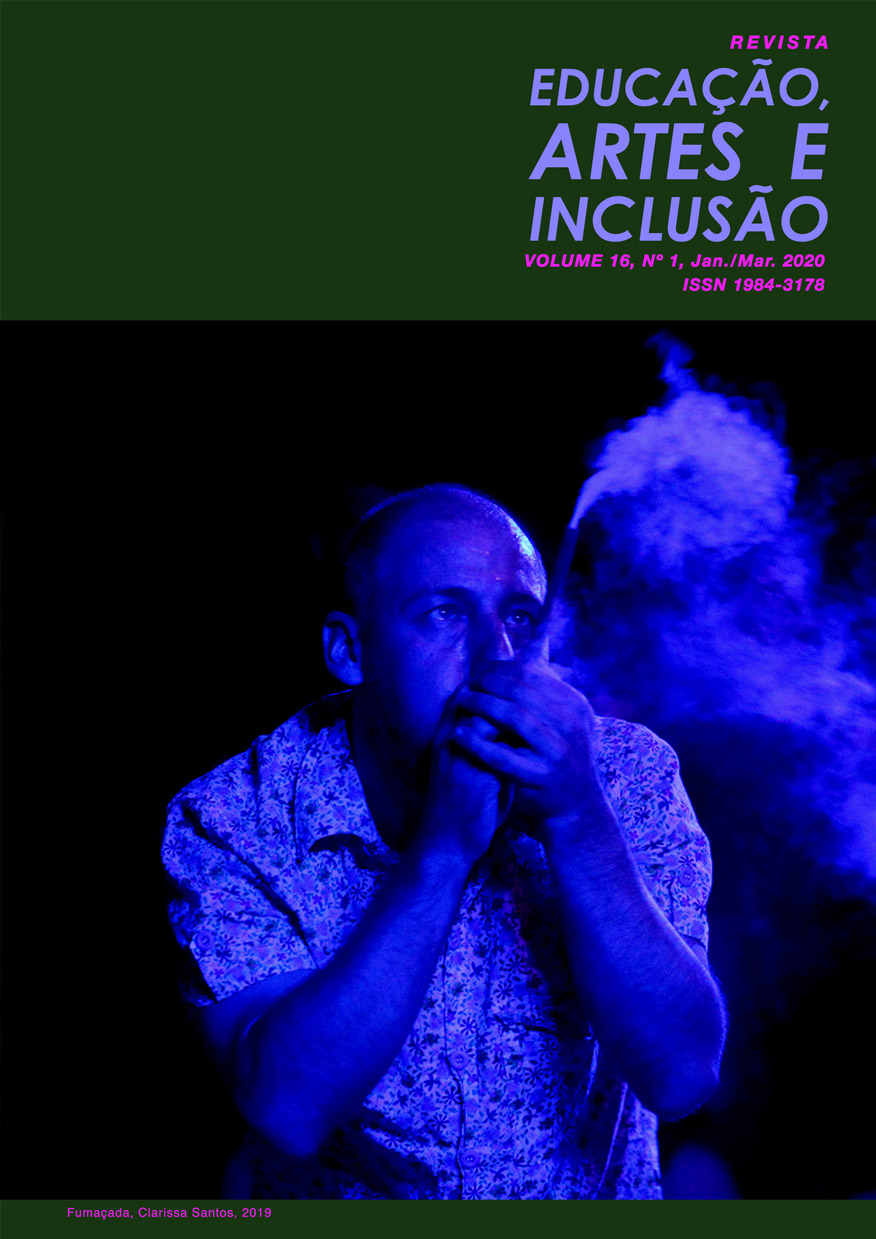O ensino de artes visuais e a formação no contexto contemporâneo
DOI:
https://doi.org/10.5965/1984317816012020358Keywords:
Ensino de Artes, Formação, Contemporaneidade,Abstract
Este artigo foi elaborado a partir das ideias geradas pelas análises e experiências vivenciadas na disciplina de Estágio Pedagógico em Artes Visuais do Curso de Licenciatura em Artes Visuais do Instituto de Artes da Universidade Estadual de Campinas (IA UNICAMP). Os conteúdos de artes estudados permearam vários temas contemporâneos que se referem às demandas do nosso tempo, como por exemplo: transversalidade, interculturalidade, identidades, diversidade, inclusão, convivência, autoconhecimento, memória, afetividade, formação, estágio, meio-ambiente, entre outros. Diante das problemáticas atuais, o professor de artes tem hoje um campo de atuação ampliado que necessita de uma atualização constante sustentada pela pesquisa teórica e prática sobre conteúdos, metodologias e didáticas variadas fomentadas pelas necessidades de públicos cada vez mais heterogêneos. Deste modo, este estudo apresenta um conjunto de análises e interconectadas com o diálogo de autores da área, incluindo a apresentação de observações e reflexões críticas formuladas por estudantes estagiários a partir da aplicação de suas práticas no ensino em Artes Visuais.
Downloads
References
ALVES, Sirlene R.; RODRIGUES, Marcelino E. Arte e afrobrasilidade como expoentes de luta e resistência. Revista Digital do LAV, Santa Maria, vol. 10, nº. 2, p. 166-189, 2017.
ARAÚJO, Gustavo C. de. Art, school and museum: the analysis of an experience in art education at the university Museum of Art - MUnA. Educ. Pesqui., São Paulo, v. 44, p. 1-18, 2018.
BARBOSA, Ana Mae. Pioneira da arte-educação, Ana Mae Barbosa reforça: “Todo artista tem o que ensinar”. NOGUEIRA, Pedro Ribeiro. Disponível em: https://portal.aprendiz.uol.com.br/2016/08/12/pioneira-da-arte-educacao-ana-mae-barbosa-reforca-todo-artista-tem-o-que-ensinar/. Acesso em: 08 fev. 2019.
CANDAU, V. M. Diferenças culturais, cotidiano escolar e práticas pedagógicas. Currículo sem Fronteiras, Rio de Janeiro, v. 11, n. 2, p. 240-255, 2011.
COELHO, Lucas C. Relatório de Estágio. Campinas. São Paulo, 2019, 24 p.
CIURCIO, Gabrielly B. Relatório de Estágio. Campinas. São Paulo, 2019, 35 p.
SESC SÃO PAULO. Congresso de Ensino/Aprendizagem das Artes na América Latina.Disponívelem:https://www.sescsp.org.br/programacao/162793_CONGRESSO+ENSINO+APRENDIZAGEM+DAS+ARTES+NA+AMERICA+LATIN?fbclid=IwAR2v0xWG5qblLZcivPqKlyq6Refu6_wUie4TEQpJrgqRjsSqU19ufozOTDs. Acesso em: 10 mai. 2019.
EISNER, Elliot. Sustainable America: Importance of Art Education. Disponível em: https://www.youtube.com/watch?v=6_76YZL_7fM. Acesso em: 20 mar. 2019.
IRWIN, Rita L. and Springgay, S. A/r/tography as practice-based research, in S. Springgay, R. Irwin, C. Leggo and P. Gouzouasis (eds), Being with A/r/tography, Rotterdam, The Netherlands: Sense, p. xix–xxxiii, 2008.
JONAS, Hans. Técnica, medicina y ética. Barcelona: Paidós, 1997.
JOSSO, Marie-Christine. A transformação de si a partir da narração de histórias de vida. Porto Alegre/RS, ano XXX, n. 3 (63), p. 413-438, 2007.
JOSSO, Marie-Christine. Experiências de vida e formação. Tradução de José Claudino e Júlia Ferreira. São Paulo: Cortez, 2004.
MARTINS, Mirian C. F. D. Arte, só na aula de arte? Educação, Porto Alegre, v. 34, n. 3, p. 311-316, 2011.
MINIBIOGRAFIAS–Congresso-2019. Disponível em: https://www.sescsp.org.br/files/unidades/abas/8fdc3392/daae/4ce5/b0f6/3021fcda7300.pdf. Acesso em: 10 mai. 2019.
NÓVOA, Antônio (Coord.).Os professores e a sua formação. 2 ed. Lisboa: Dom Quixote,1995.
PIMENTEL, Lucia. Cognição Imaginativa. Revista Pós: Belo Horizonte, v. 3, n. 6, p. 96 - 104, 2013.
READ, Herbert. Arte e alienação. Rio de Janeiro: Zahar, 1968.
REILY, Lucia. O ensino de artes visuais na escola no contexto da inclusão. Cad. Cedes, Campinas, vol. 30, n. 80, p. 84-102, 2010.
SANTOS, Bruno C. dos. Relatório de Estágio. Campinas. São Paulo, 2019, 20 p.
SANTOS, Victor. Relatório de Estágio. Campinas. São Paulo, 2019, 35 p.
SENICIATO, Tatiana; CAVASSAN, Osmar. O Ensino de Ecologia e a Experiência Estética no Ambiente Natural: Considerações Preliminares. Ciência & Educação, v. 15, n. 2, p. 393-412, 2009.
SIMÃO, Selma M. Eu, meu bairro, nosso mundo - Educação não formal, saberes e prazeres. Holambra, SP: Editora Setembro, 2014.
STEELE, Jamie Simpson. Where are They Now? Graduates of an Arts Integration Elementary School Reflect on Art, School, Self and Others. International Journal of Education & the Arts. Volume 20, Number 11, 2019.
SUBTIL, Maria José Dozza. EDUCAÇÃO E ARTE: dilemas da prática que a História pode explicar. Práxis Educativa, Ponta Grossa, v.4, n.2, p.185-194, 2009.
WOYWOD, Christine; DEAL, Raoul. Art That Makes Communities Strong: Transformative Partnerships With Community Artists in K–12 Settings. Journal , Volume 69, 2016 - Issue 2, 2016.
Downloads
Published
How to Cite
Issue
Section
License
Copyright Statement
The Educação, Artes e Inclusão is a journal that follows the Free Access Policy. The articles published by the journal are free of charge, intended for educational and non-commercial applications. The articles whose authors are identified represent the expression from the point of view of their authors and not the official position of the Educação, Artes e Inclusão Journal or the Educação, Artes e Inclusão Research Group.
Authors who publish in this journal agree to the following terms:
(A) Authors retain the copyright and grant the journal the right of first publication, with the work simultaneously licensed under the Creative Commons Attribution License which allows the sharing of the work with acknowledgment of authorship and initial publication in this magazine.
(B) Authors are authorized to take additional contracts separately, for non-exclusive distribution of the version of the work published in this journal (eg publish in institutional repository or as a book chapter), with acknowledgment of authorship and initial publication in this magazine.
(C) This journal provides public access to all of its content, as this allows for greater visibility and scope of published articles and reviews. For more information on this approach, visit the Public Knowledge Project.
This journal is licensed under a Creative Commons Attribution-NonCommercial-ShareAlike 4.0 International License. This license allows others to remix, adapt and create from your work for non-commercial purposes, and although new work must give you due credit and cannot be used for business purposes, users do not have to license such derivative works under the same terms.



